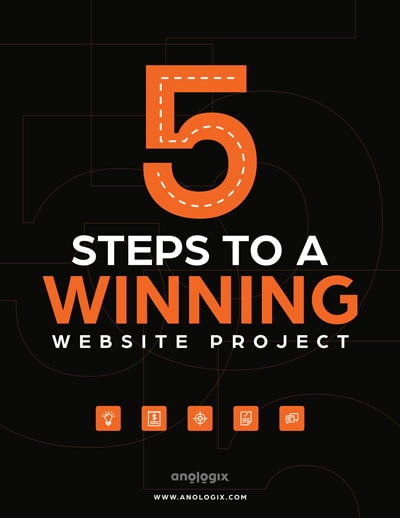
Website Mistakes Small Businesses Should Avoid

It's 2023, and having a website for your small business is more important than ever. Whether you currently have a website that you're trying to perfect or are wanting to create one for the first time, it's not a task that should be taken lightly. Your website has a job to do: it represents your business, serves as a sales funnel for your products, engages your audience, connects to other channels, climbs search engine rankings, and collects leads.
It's so important to take the time to set your business up for success in the online world from the beginning, yet so many business owners are making mistakes that can easily be avoided. Small businesses with a website have a competitive advantage over those that don't. In this article, we are going to go over some of the most common mistakes small businesses are making in the online world and how you can avoid them.
Mistake #1: Relying on Social Media as Your Website
A lot of small businesses worry that they can't have an online presence because they don't know website code, and therefore rely solely on social media platforms for their website. By relying only on 3rd party websites as your primary hub, you're missing out on a ton of potential leads and sales. You also don't have any control over the changes that are made to content, access, and policies.
Mistake #2: Building a Website without a Plan
If you want to build a successful and profitable website, you need a strategy. By having a plan for your website, you're able to define who your audience is, what your goals are, and what kind of content and design you want. When coming up with your website plan, here are a few things to consider:
- Who is your targeted audience?
- What are your goals?
- How will you measure your success?
- What information do you want to get from customers?
- What functionalities does your website need?
- What other platforms and apps will your site connect to?
By having a strategy for your website, not only will you end up building a well-designed and functioning site, but you'll also be reaching a huge accomplishment for your business as well!
Mistake #3: Your Website Design Doesn't Reflect Your Brand
Sometimes a small business's online and offline presence doesn't quite match up. It could be that their branding is a bit off, or their website doesn't reflect the kind of professionalism people see in the store. You need to make sure you create a good impact with your site design because a good design can elevate the entire brand experience.
By having a well-designed website that accurately reflects your brand, you can connect with your audience on a more effective level, tell a story, provide relevant information to your customers, entertain, educate, and excite your visitors, and you can solve complicated problems from within the website.
Your website doesn't have to be overly complicated to be well-designed. In fact, having a simple design for a small business can be extremely profitable. Don't burden your visitors with too many different functions, options, and stimuli - that will just lead to confusion, which will likely make the customer leave.
When coming up with ideas to design your website, here are a couple of things to keep in mind:
- Be practical in your use of design elements such as fonts and colors.
- White space draws eyes to important elements on a page - use it to your advantage.
- Don't go off in too many directions, decide on a main theme design and stick to it.
Mistake #4: Not Knowing How to Update Your Website
Some small business owners outsource all their web development tasks to agencies and contractors. While it can be helpful for a small business to unload some of their web responsibilities on someone else, it might not be the best idea to outsource everything without learning how to complete some of the simple tasks yourself.
Letting someone else deal with everything can make it difficult to make changes when and where you want them. Depending on the contractor, you might have to go through several people and wait a few days before the changes are made.
It's perfectly okay to hire a web developer to design, publish, update, and manage your site. But make sure you have access to the backend of your website and get the training you need so that you can make simple changes and additions on your own if you need to.
If you decide to hire a web developer, make sure they take the time to go over how to complete easy updates on your website, like adding a new blog post or updating your business's phone number.
Mistake #5: You Don't Have Clear Call-to-Actions
When people visit a website, believe it or not, they actually want to be told what to do! Make sure you clearly state the actions you want people to take. For each page on your website, think about how and where you can add a call-to-action. Use things such as alert bars, pop-up forms, and buttons.
The goal of your website is to capture leads and convert them into customers, so make sure your lead forms are distinguished and click-worthy. If you're worried that people won't want to give out their information to you, think about providing them something in return for free. People are much more willing to share personal information like their name or email when they get something out of it, like newsletters and coupons.
Mistake #6: Your Website Isn't Mobile Friendly
Did you know that nearly 1/3 of all website traffic comes from mobile devices like phones and tablets, yet 90% of small businesses haven't designed their website to fit these screens? When you fail to have a responsive site (one that is optimized for all devices), not only are you hurting your search engine rankings, but you also look unprofessional.
To test if your website is responsive or could use some improvement, you can use Google's free Mobile-Friendly Test. All you have to do is enter your URL. Then Google will rate your website based on it's mobile-friendliness using color-coded guides.
Mistake #7: Letting Design Take Priority over Conversion
Design should not come before conversion. Your website has a job to do - it needs to give people the right information and be user-friendly, so you need to build your content, design, and layout to support that.
Don't think of your website as a digital billboard - it should be so much more than that. Use it as a lead-generator that supports your business and helps it grow.
Mistake #8: Not Refreshing Your Website after Publishing It
Don't make the mistake of leaving your website after it's published. Website management still needs to be done once everything is up and running. You should refresh your website consistently based on how it's performing.
Google Analytics is a great tool that can help you understand your website, see how well you are performing, and figure out what areas need more improvement. For example, if you have a page with low traffic, you can find ways to link to it from other pages in order to increase the number of visits.
Another great reason to keep your website up to date is SEO. By posting blogs and other social content, you are keeping your website fresh, which is one of the many things Google takes into their ranking considerations.
Mistake #9: Forgetting About SEO
In most cases, an online experience starts with a web search, and there are about 3.5 billion searches done per day. With so many people searching, someone is bound to be looking for your industry or business. Having an online presence supported by organic search is incredibly invaluable. People are searching for you online, and SEO (search engine optimization) helps them to find you.
Google has an algorithm with several ranking factors, such as page content, URLs, images, and title tags. You might be wondering what you can do to boost your ranking in organic search. Here are a few tips:
- Increase the length of your pages. Make sure you have a good amount of words on your webpages. This matters for SEO because Google wants to make sure you're offering enough text for website visitors and crawlers to review and index.
- Don't neglect using metadata and keywords. Research what keywords are primarily searched for in your industry. Focus on optimizing every page of your site with one primary keyword on each page, then use it on header tags, metadata (meta titles, meta descriptions, and keywords), body copy, URL, and alt tags (images).
- Make sure your website is speedy. Page speed has become a huge priority, especially for search engines like Google. Search engines have begun to penalize webpages that have slow loading times in pay-per-click campaigns and organic search. How quickly your web pages load will affect your ranking and bounce rate.
Conclusion
Before building your small business website, remember that by taking the time to come up with a good plan and design, you are more likely to have a successful site. We know that small businesses can have their hands full with other things though, and if you need any help developing an awesome, new website, reach out to us at AnoLogix!
FREE Guide
Get 5 Steps to a Winning Website e-Book
